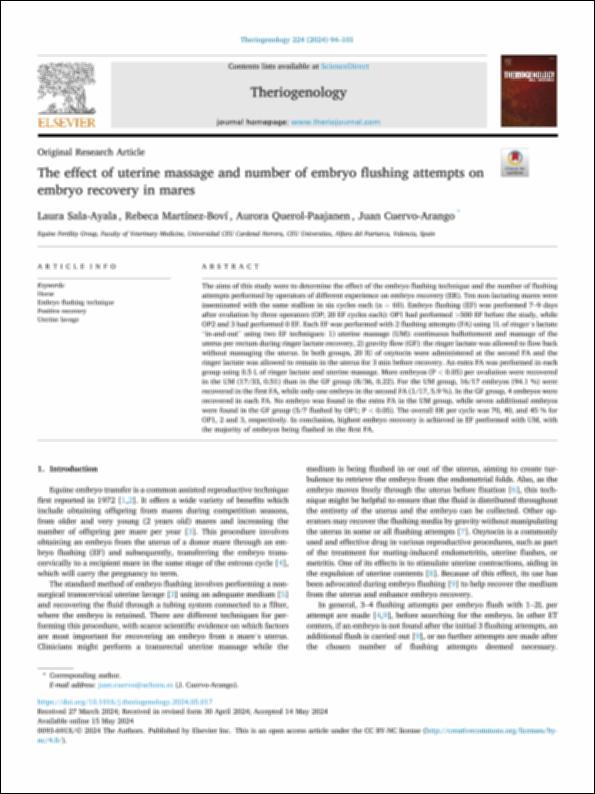Por favor, use este identificador para citar o enlazar este ítem:
http://hdl.handle.net/10637/15885The effect of uterine massage and number of embryo flushing attempts on embryo recovery in mares
| Título : | The effect of uterine massage and number of embryo flushing attempts on embryo recovery in mares |
| Autor : | Sala Ayala, Laura Martínez Boví, Rebeca Querol Paajanen, Aurora Cuervo-Arango Lecina, Juan |
| Materias: | Procreación artificial; Artificial procreation; Genética animal; Animal genetics; Caballo; Horses; Embrión; Embryos; Veterinaria; Veterinary medicine |
| Editorial : | Elsevier |
| Citación : | Sala Ayala, L., Martínez Boví, R., Querol Paajanen, A. & Cuervo-Arango, J. (2024). The effect of uterine massage and number of embryo flushing attempts on embryo recovery in mares. Theriogenology, vol. 224 (aug.), pp. 94-101. DOI: https://doi.org/10.1016/j.theriogenology.2024.05.017 |
| Resumen : | The aims of this study were to determine the effect of the embryo flushing technique and the number of flushing attempts performed by operators of different experience on embryo recovery (ER). Ten non-lactating mares were inseminated with the same stallion in six cycles each (n = 60). Embryo flushing (EF) was performed 7–9 days after ovulation by three operators (OP; 20 EF cycles each): OP1 had performed >500 EF before the study, while OP2 and 3 had performed 0 EF. Each EF was performed with 2 flushing attempts (FA) using 1L of ringer's lactate “in-and-out” using two EF techniques: 1) uterine massage (UM): continuous ballottement and massage of the uterus per rectum during ringer lactate recovery, 2) gravity flow (GF): the ringer lactate was allowed to flow back without massaging the uterus. In both groups, 20 IU of oxytocin were administered at the second FA and the ringer lactate was allowed to remain in the uterus for 3 min before recovery. An extra FA was performed in each group using 0.5 L of ringer lactate and uterine massage. More embryos (P < 0.05) per ovulation were recovered in the UM (17/33, 0.51) than in the GF group (8/36, 0.22). For the UM group, 16/17 embryos (94.1 %) were recovered in the first FA, while only one embryo in the second FA (1/17, 5.9 %). In the GF group, 4 embryos were recovered in each FA. No embryo was found in the extra FA in the UM group, while seven additional embryos were found in the GF group (5/7 flushed by OP1; P < 0.05). The overall ER per cycle was 70, 40, and 45 % for OP1, 2 and 3, respectively. In conclusion, highest embryo recovery is achieved in EF performed with UM, with the majority of embryos being flushed in the first FA. |
| URI : | http://hdl.handle.net/10637/15885 |
| Derechos: | http://creativecommons.org/licenses/by-nc/4.0/deed.es Open Access |
| ISSN : | 0093-691X 1879-3231 (Electrónico) |
| Cubierto por: | Acuerdo Transformativo – 2024 |
| Fecha de publicación : | ago-2024 |
| Centro : | Universidad Cardenal Herrera-CEU |
| Aparece en las colecciones: | Dpto. Medicina y Cirugía Animal |
Los ítems de DSpace están protegidos por copyright, con todos los derechos reservados, a menos que se indique lo contrario.


